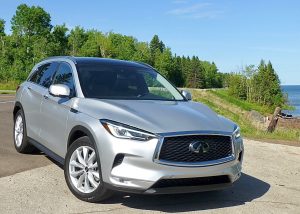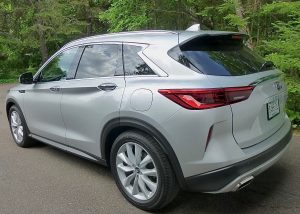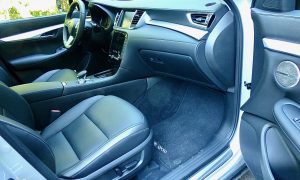Varied compression makes QX50 constant

In the ever-expanding Infiniti SUTV stable, the 2019 QX50 is something special — with variable compression power.
By John Gilbert
In the long list of Nissan and Infiniti cars, crossovers and SUVs, the new Infiniti QX50 is one of the neatest, best-designed and best-performing of all.
And that’s before even getting into the amazing technology deployed under the hood.As the driver, you do nothing to make it work except step on the gas. Moderately, please.
It is called “variable compression” and it actively alters the engine’s compression ratio into a mind-blowing range from the low 8-to-1 figure common to older car buyers who seek high gas mileage, to more than a 14-to-1 ratio that best exemplifies the most high-tech performers.
Automotive engineers always have been striving to improve efficiency of internal combustion engines, seeking ways to achieve the magic trio of increased power, increased fuel economy, and decreased emissions. Direct fuel injection and computerized engine operation have helped, and variable valve timing has been a brilliant breakthrough in the last decade, including such tricks as Atkinson Cycle and Miller Cycle to alter valve timing and coax the air-fuel mixture to spend more time combusting.

The engine shroud doesn’t tip off that the 2.0-liter turbo 4 has 268 horsepower and 280 foot-pounds of torque.
In the four cycles — intake, compression, combustion and exhaust — an engine’s ability to streamline the process and increase the ability to most-thoroughly burn the air-fuel mixture for maximum power and efficiency has included Honda’s stratified-charge engines and decades of refining it, and more recently is Mazda’s Skyactive concept combining all its technology into a clean-sheet, holistic new way to build modern engines.
All are worthy, as are any and all the other top world car-makers’ efforts, most of which are aimed at taking best advantage of whatever a car’s compression ratio might be.
Nissan, however, has a bunch of impatient perfectionist types wearing white smocks who probably would prefer to pass up the chance to take the family to the lake in favor of building their own lake in the back yard. These engineers started 20 years ago to seek a newer and better idea, and make it happen.
So many of Nissan’s newest cars and engines are impressive to drive, that I always look forward to trying another one. As for this technique, I knew it was coming, I just wasn’t sure when it would find its way to real-world applications. The better idea of varying valve-timing to help combustion instead becomes the best idea of building an engine capable of altering its own compression ratio to take optimum advantage of any valve operation.
When a shiny new 2019 Infiniti QX50 showed up in my Duluth driveway, I liked the looks because it is only slightly larger than the sleek and lower QX30, and nowhere as large and, dare I say, bulbous of larger examples of the QX fleet, or the giant Nissan Armada, for that matter. But before starting it up, I sought out the sticker sheet to see whether it had a turbo 4-cylinder or a V6 or V8. Then I read the fine print: “2.0L Variable Compression Turbo 4-cylinder engine, 268 horsepower, 280 foot-pounds of torque. All-wheel drive.”
Aha! Here it is. I couldn’t wait to drive it, and it was more than merely impressive. Starting from a stop sign to pull onto a freeway stretch northeast of Duluth, I saw a car coming in the distance so I hit the gas hard. The QX50 virtually leaped out from under me. Impressive. A short time later, I was at a stop light on a steep avenue in downtown Duluth, and when I attempted to start up moderately, again it shot across the intersection as if it couldn’t wait to tackle the hill.
If you gave a ride to an unsuspecting passenger, excuse them for assuming the QX50 has a V8. That’s how good the variable-combustion engine and the turbo operate to turn the QX50 into a screamer.
Refinements are everywhere in the vehicle, with fine leather on the seats, neat aluminum trim around the dash and doors, high-tech instrumentation, and a firmness to the ride that conveys stability, which can be amplified by a mode switch to engage normal, sport, personal choice or eco. It has a CVT (continuously variable transmission) which is something Nissan has stubbornly championed over the years, but this one has paddles on the steering wheel that allow you to shift past the usual drone of a CVT and further bring the QX50 to life.
But after all the high-tech safety features like blind-spot warning, parking sensors and surround-view assurance that you won’t bump into anything front or rear, rain-sensing wipers and all the connectivity you could want, the true magic of the QX50 goes back to the drivetrain.
In cross-section, we know the pistons are connected by rods to the crankshaft, which spins down below in the block and forces the up and down action of the pistons. In the QX50, the bottom end of the connecting rod is replaced by an odd-shaped thing that seems off-cadence from round, which it is, and it is coordinated via a couple of knuckles and shafts to an electronically controlled “harmonic drive mechanism” which also rotates. The components and all the various links and shafts to coordinate all the components to turn and spin at a precise rate to vary the piston’s stroke.
Most consumers won’t care or try to understand, and will be more than satisfied to simply know the end result. If you need power, step hard on the gas and the compression ratio plunges to 8:1 and the computer alerts the turbocharger to spin faster to avert unwanted detonation. Let off the gas and the compression ratio smoothy changes, up to 14:1 for maximum fuel-economy at light or normal use.
In other words, we consumers never realized that the compression ratio of our cars was either too high or too low, and maybe only occasionally right on for the type of driving we do every day. Now Nissan proves you can have a vehicle with any imaginable compression ratio to alter itself and provide perfect operation for however hard you’re seeking power.
There is no secret to the fact that if an engine burns its fuel more completely, the result is more power, and as a by-product, improved fuel economy. It goes without saying that emissions also improve by the deduction that the air-fuel mix is more completely burned.
I was able to attain an actual 30.1 miles per gallon while scaling the hillsides of Duluth and showing off the QX50’s remarkable performance.
A premium Bose audio system with 16 speakers complements all the safety items, and the feel of driving the vehicle is enhanced by the neat little contoured ridges rising up on either side of the hood. The signature grille looks quite similar to those found on the larger and smaller Infiniti SUVs, but in my humble opinion, it looks its best on the QX50.
Standard price on the QX50 is about $45,000, while the test vehicle stickered at $49,685. That includes various packages, and an enormous sunroof that stretches nearly from front to rear. That’s good for those in the rear, who might grow weary on a trip of watching all those trees flash by as dad or mom hits the gas to show off what will surely become the latest definition of high-tech driving pleasure.







 John Gilbert is a lifetime Minnesotan and career journalist, specializing in cars and sports during and since spending 30 years at the Minneapolis Tribune, now the Star Tribune. More recently, he has continued translating the high-tech world of autos and sharing his passionate insights as a freelance writer/photographer/broadcaster. A member of the prestigious North American Car and Truck of the Year jury since 1993. John can be heard Monday-Friday from 9-11am on 610 KDAL(www.kdal610.com) on the "John Gilbert Show," and writes a column in the Duluth Reader.
John Gilbert is a lifetime Minnesotan and career journalist, specializing in cars and sports during and since spending 30 years at the Minneapolis Tribune, now the Star Tribune. More recently, he has continued translating the high-tech world of autos and sharing his passionate insights as a freelance writer/photographer/broadcaster. A member of the prestigious North American Car and Truck of the Year jury since 1993. John can be heard Monday-Friday from 9-11am on 610 KDAL(www.kdal610.com) on the "John Gilbert Show," and writes a column in the Duluth Reader.